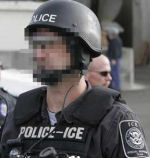 The speech given this morning by Secretary of Defense Robert Gates to a business group detailing the administration’s plan for export reform is now posted on the Department of Defense website and can be found here. It is an ambitious and laudable proposal and one that, unfortunately, will likely die a slow and painful death on the floor of the dead-locked Senate.
The speech given this morning by Secretary of Defense Robert Gates to a business group detailing the administration’s plan for export reform is now posted on the Department of Defense website and can be found here. It is an ambitious and laudable proposal and one that, unfortunately, will likely die a slow and painful death on the floor of the dead-locked Senate.
Significantly, Gates proposed that the United States treat exports in the way that almost all of our allies do — with one unified list administered by one agency. The only real downside here would be the possibility that the employees of the two rival agencies — the Directorate of Defense Trade Controls (“DDTC”) at State and the Bureau of Industry and Security (“BIS”) at Commerce — would still not be able to play nicely with each other even when under the same roof. Gates alluded to the inability of the two agencies to get along when he mentioned an inter-agency struggle between BIS and DDTC with respect to jurisdiction over millimeter wave scanning machines. This squabble delayed the placement of these high-tech passenger screening machines in foreign airports and needlessly endangered U.S. citizens and others flying through those airports while the issue was being resolved. (BIS ultimately won that battle.)
Repeating the maxim often credited to Frederick the Great — “He who defends everything, defends nothing” — Gates also proposed that the unified list be tiered, with the “crown jewels” requiring the most stringent controls at the top and less sensitive technologies requiring fewer controls be placed in lower tiers. The unification push would also apply to the various lists of prohibited end users, which Gates proposed be consolidated into a single list.
Finally, Secretary Gates touched on an area near and dear to most exporters’ hearts — the impossibly narrow exemptions and license exceptions relating to exports of parts and components for items that have already been legally exported:
[M]any parts and components of a major piece of defense equipment – such as a combat vehicle or aircraft – require their own export licenses. It makes little sense to use the same lengthy process to control the export of every latch, wire, and lug nut for a piece of equipment like the F-16, when we have already approved the export of the whole aircraft.
Under DDTC rules an exemption — found in section 123.16(b)(2) of the ITAR — is only available for shipments worth less than $500 (and only 24 shipments per year are permitted.) BIS provides a license exception for parts and components, but only for one-to-one replacement. Parts being shipped to inventory require a license. A unified exemption with a higher shipment value limit and without the one-to-one replacement requirement would be a reform welcomed by most, if not all, exporters.
Rounding out in Gates speech what Defense Department officials referred to in a prior briefing as the “four singles” were the last two: one enforcement agency to bring them all and in one IT system bind them. Of course, Gates refrained from the Tolkien paraphrase that I couldn’t resist.
Regarding a unified IT system, here’s a question for Export Law Blog readers. As between DDTC’s D-Trade electronic licensing system and BIS’s SNAP-R electronic licensing system, which would you like to see survive and why? Or should they both be trashed and replaced with an entirely new system? Please share your thoughts on these questions in the comment section.
UPDATE: This White House fact sheet explains that the proposed reform will be implemented in three phases, with only the last phase requiring action by Congress. The second phase is set to be completed by the end of this year and will include the initial restructuring of the USML and CCL into tiered lists.
 An article (subscription required) in the latest issue of Inside U.S. Trade describes an interview the publication held with a “senior administration official” on the White House’s proposed export control reforms. According to the official, an interagency agreement should occur shortly that will allow the agencies to move forward in implementing one export license application form for BIS, OFAC and DDTC and to paring down the various export control lists to one list of critical items and technologies.
An article (subscription required) in the latest issue of Inside U.S. Trade describes an interview the publication held with a “senior administration official” on the White House’s proposed export control reforms. According to the official, an interagency agreement should occur shortly that will allow the agencies to move forward in implementing one export license application form for BIS, OFAC and DDTC and to paring down the various export control lists to one list of critical items and technologies.
 Posted by
Posted by  Category:
Category: 


 California-based Telogy LLC (“Telogy”), a distributor of test equipment,
California-based Telogy LLC (“Telogy”), a distributor of test equipment,  A court battle raging between Italian company Tiber Aviation s.r.l. and Bell Helicopter Textron Inc. turns on whether Tiber was actually intending to ship a helicopter to Iran or whether Bell told that story to a special agent of the Bureau of Industry and Security (“BIS”) in order to secure the government’s help in repossessing the helicopter. The latest chapter in the saga
A court battle raging between Italian company Tiber Aviation s.r.l. and Bell Helicopter Textron Inc. turns on whether Tiber was actually intending to ship a helicopter to Iran or whether Bell told that story to a special agent of the Bureau of Industry and Security (“BIS”) in order to secure the government’s help in repossessing the helicopter. The latest chapter in the saga  The speech given this morning by Secretary of Defense Robert Gates to a business group detailing the administration’s plan for export reform is now posted on the Department of Defense website and can be found
The speech given this morning by Secretary of Defense Robert Gates to a business group detailing the administration’s plan for export reform is now posted on the Department of Defense website and can be found 

